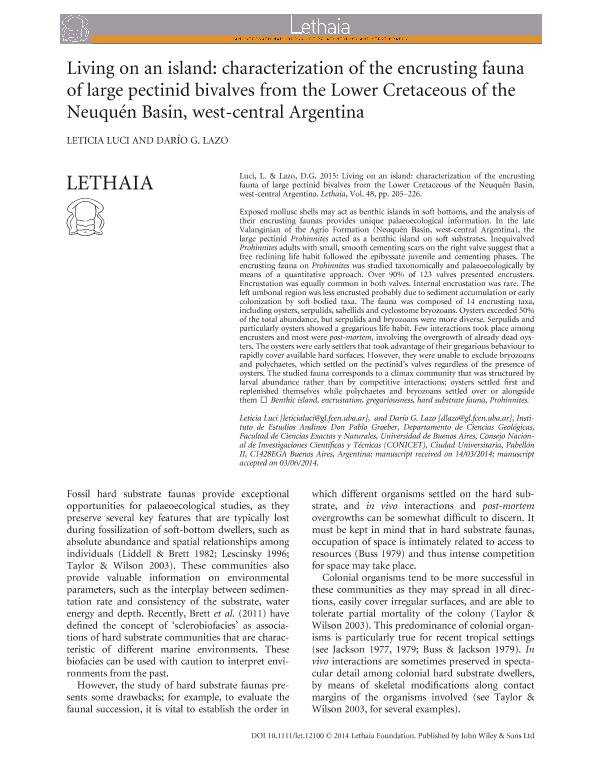Artículo
Living on an island: characterization of the encrusting fauna of large pectinid bivalves from the Lower Cretaceous of the Neuquén Basin, west-central Argentina
Fecha de publicación:
09/2015
Editorial:
Wiley
Revista:
Lethaia
ISSN:
0024-1164
Idioma:
Inglés
Tipo de recurso:
Artículo publicado
Clasificación temática:
Resumen
Exposed mollusc shells may act as benthic islands in soft bottoms, and the analysis of their encrusting faunas provides unique palaeoecological information. In the late Valanginian of the Agrio Formation (Neuquén Basin, west-central Argentina), the large pectinid Prohinnites acted as a benthic island on soft substrates. Inequivalved Prohinnites adults with small, smooth cementing scars on the right valve suggest that a free reclining life habit followed the epibyssate juvenile and cementing phases. The encrusting fauna on Prohinnites was studied taxonomically and palaeoecologically by means of a quantitative approach. Over 90% of 123 valves presented encrusters. Encrustation was equally common in both valves. Internal encrustation was rare. The left umbonal region was less encrusted probably due to sediment accumulation or early colonization by soft-bodied taxa. The fauna was composed of 14 encrusting taxa, including oysters, serpulids, sabellids and cyclostome bryozoans. Oysters exceeded 50% of the total abundance, but serpulids and bryozoans were more diverse. Serpulids and particularly oysters showed a gregarious life habit. Few interactions took place among encrusters and most were post-mortem, involving the overgrowth of already dead oysters. The oysters were early settlers that took advantage of their gregarious behaviour to rapidly cover available hard surfaces. However, they were unable to exclude bryozoans and polychaetes, which settled on the pectinid's valves regardless of the presence of oysters. The studied fauna corresponds to a climax community that was structured by larval abundance rather than by competitive interactions; oysters settled first and replenished themselves while polychaetes and bryozoans settled over or alongside them.
Palabras clave:
Encrustation
,
Benthic Island
,
Prohinnites
,
Gregariousness
,
Hard Substrate Fauna
Archivos asociados
Licencia
Identificadores
Colecciones
Articulos(IDEAN)
Articulos de INSTITUTO DE ESTUDIOS ANDINOS "DON PABLO GROEBER"
Articulos de INSTITUTO DE ESTUDIOS ANDINOS "DON PABLO GROEBER"
Citación
Luci, Leticia; Lazo, Dario Gustavo; Living on an island: characterization of the encrusting fauna of large pectinid bivalves from the Lower Cretaceous of the Neuquén Basin, west-central Argentina; Wiley; Lethaia; 48; 2; 9-2015; 205-226
Compartir
Altmétricas




